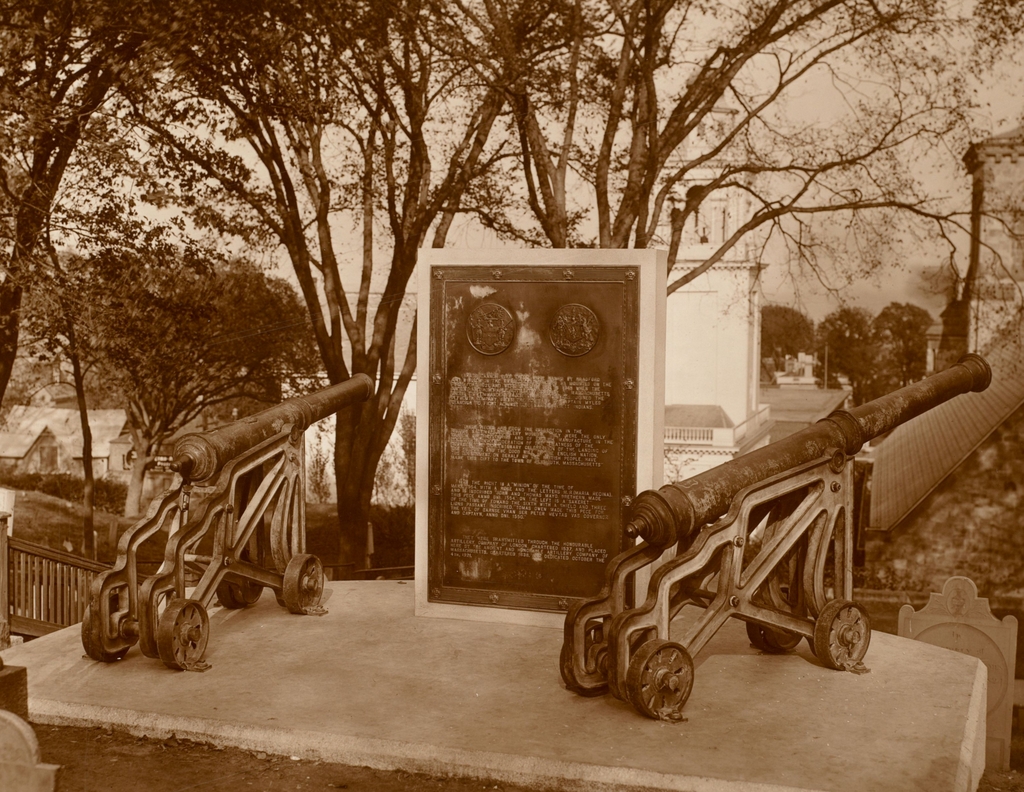Cannons and a historical marker near the site of the Pilgrim fort on Burial Hill in Plymouth, in October 1921. Image courtesy of the Boston Public Library, Plymouth Tercentenary Photographs collection. Photographed by Edward P. McLaughlin.
The scene in 2023:
These two photos show a monument on Burial Hill that was installed as part of the 300th anniversary celebration of the start of the Plymouth Colony. Burial Hill is located about a quarter mile west of Plymouth Harbor, and it rises about 120 feet above sea level. Prior to its use as a graveyard, the early Plymouth colonists constructed a fort here, since the elevated land provided expansive views of the town and the harbor.
The first fort here was built soon after their arrival in 1620, but a larger, more substantial one replaced it two years later. This second fort, which also served as the town’s meetinghouse, was located on the southeastern part of the hill, near the spot where these two photos were taken. Governor William Bradford described it in his journal Of Plymouth Plantation, writing:
This somer they builte a fort with good timber, both strong & comly, which was of good defence, made with a flate rofe & batllments, on which their ordnance were mounted, and wher they kepte constante watch, espetially in time of danger. It served them allso for a meeting house, and was fitted accordingly for that use. It was a great worke for them in this weaknes and time of wants; but ye deanger of ye time required it, and both ye continuall rumors of ye fears from ye Indeans hear, espetially ye Narigansets, and also ye hearing of that great massacre in Virginia, made all hands willing to despatch ye same.
The defenses here on the hill were subsequently expanded, including the construction of a brick watchtower in 1643. By 1676, though, it was no longer necessary following the end of King Philip’s War. The structures here were dismantled, and by 1679 the hill was in use as a graveyard. The oldest stone on the hill dates back to 1681, and the hill would continue to be used as an active burial ground throughout the colonial era and into the early 19th century.
By the late 19th century, the story of the Mayflower had become a key part of the country’s founding narrative, aided in part by popular depictions of the Pilgrims, such as Henry Wadsworth Longfellow’s poem, The Courtship of Myles Standish. This interest in Plymouth carried into the 20th century, eventually culminating with the tercentenary of 1920-1921.
It was during this tercentenary celebration that a new portico was constructed above Plymouth Rock, but there were also other monuments installed around Plymouth during this time, including one here on the site of the old fort, which is shown in these two photos. This monument was sponsored by the Ancient and Honorable Artillery Company of Massachusetts, and it originally featured two bronze cannons, which were donated by the British government. The bronze plaque between the cannons describes the history of both the site and the cannons, and it reads:
Brass cannon like these were named by Bradford and Winslow in the annals of Plymouth as mounted on the first fort, 1621, and were still in use in 1645 when the Ancient and Honorable Artillery Company of Massachusetts under its commander Major General Gibbons joined the Plymouth company under the command of Captain Myles Standish to fight against the Narragansett Indians.
These pieces are from the collection in the British National Artillery Museum. They were the only cannon of that period and of English manufacture in the collection “in consideration of the greatness of the occasion, the tercentenary celebration of the landing of the Pilgrims, and the good will of the English nation, the government, on behalf of the British people, have made this gift to the town of Plymouth, Massachusetts.”
On the right is a “minion” of the time of Mary, 1554, with a rose and the letters M.R. (Maria Regina) and is inscribed “John and Thomas Mayo, brethren, made this pece anno dni 1554.” On the left is a “Sakeret” of the time of Edward the Sixth with a shield and three lions passant inscribed “Thomas Owen made this pece for the ye’l of carnse vhan ser Peter Mevtas vas governor and captayn, anno dni 1550.”
They were transmitted through the Honourable Artillery Company of London, chartered 1537, and placed here by the Ancient and Honorable Artillery Company of Massachusetts, chartered 1638, and dedicated October the 4th, 1921.
The keynote speaker at the dedication event was William H. P. Faunce, the president of Brown University. He took the opportunity to advocate for stronger ties between Britain and the United States, and he also addressed some of the concerns that some Americans evidently had about British human rights violations. Faunce pointed out that, while many would point to British actions in Ireland and India, America was likewise guilty of injustices against other groups of people.
The cannons would remain here for over 60 years, but they were ultimately removed in 1985 to protect them from the effects of weathering. The one on the left was returned to Britain, and the one on the right is now on display at the Pilgrim Hall Museum here in Plymouth. Then, in 2020, the Ancient and Honorable Artillery Company donated a replica cannon to the town. It is intended to eventually be placed here on Burial Hill, but as of May 2023 it has not yet been installed.


